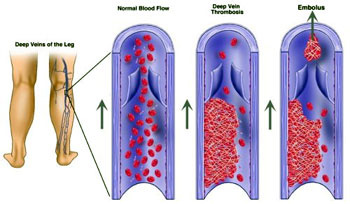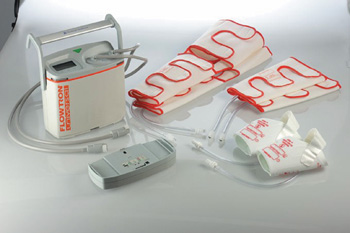A Patients Guide to the Post Operative use of a Sequential Compression Device (SCD)
What is DVT?
 Deep vein thrombosis (throm-BO-sis), or DVT, is a blood clot that forms in a vein deep in the body. Blood clots occur when blood thickens and clumps together.
Deep vein thrombosis (throm-BO-sis), or DVT, is a blood clot that forms in a vein deep in the body. Blood clots occur when blood thickens and clumps together.
Most deep vein blood clots occur in the lower leg or thigh. They also can occur in other parts of the body.
A blood clot in a deep vein can break off and travel through the bloodstream. The loose clot is called an embolus. It can travel to an artery in the lungs and block blood flow. This condition is called pulmonary embolism or PE.
PE is a very serious condition. It can damage the lungs and other organs in the body and cause death.
What are the causes?
Blood clots can form in your body's deep veins if:
- A vein's inner lining is damaged. Injuries caused by physical, chemical, or biological factors can damage the veins. Such factors include surgery, serious injuries, inflammation, and immune responses.
- Blood flow is sluggish or slow. Lack of motion can cause sluggish or slow blood flow. This may occur after surgery, if you're ill and in bed for a long time, or if you're traveling for a long time.
- Your blood is thicker or more likely to clot than normal. Some inherited conditions increase the risk of blood clotting. Hormone therapy or birth control pills also can increase the risk of clotting.
Who is at risk of DVT?
The risk factors for deep vein thrombosis (DVT) include:
- A history of DVT.
- Overweight or Obesity.
- Conditions or factors that make your blood thicker or more likely to clot than normal. Some inherited blood disorders will do this. Hormone therapy or birth control pills also increase the risk of clotting.
- Injury to a deep vein from surgery, a broken bone, or other trauma.
- Slow blood flow in a deep vein due to lack of movement. This may occur after surgery, if you're ill and in bed for a long time, or if you're traveling for a long time.
- Pregnancy and the first 6 weeks after giving birth.
- Recent or ongoing treatment for cancer.
- A central venous catheter. This is a tube placed in a vein to allow easy access to the bloodstream for medical treatment.
- Older age. Being older than 60 is a risk factor for DVT, although DVT can occur at any age.
- Smoking
Your risk for DVT increases if you have more than one of the risk factors listed above.
What are the Signs and Symptoms of DVT?
The signs and symptoms of deep vein thrombosis (DVT) might be related to DVT itself or pulmonary embolism (PE). See your doctor right away if you have signs or symptoms of either condition. Both DVT and PE can cause serious, possibly life-threatening problems if not treated.
Deep Vein Thrombosis
Only about half of the people who have DVT have signs and symptoms. These signs and symptoms occur in the leg affected by the deep vein clot. They include:
- Swelling of the leg or along a vein in the leg
- Pain or tenderness in the leg, which you may feel only when standing or walking
- Increased warmth in the area of the leg that's swollen or painful
- Red or discolored skin on the leg
Pulmonary Embolism
ome people aren't aware of a deep vein clot until they have signs and symptoms of PE. Signs and symptoms of PE include:
- Unexplained shortness of breath
- Pain with deep breathing
- Coughing up blood
Rapid breathing and a fast heart rate also may be signs of PE.
What are the treatment options for DVT?
Physicians seek to treat the existing clot as well as prevent pulmonary embolism and further clotting episodes. They may recommend a combination of drugs and surgical procedures, including:
- Anticoagulants;
- Drugs to break up clots or dissolve clots;
- Percutaneous thrombectomy; and
- Surgical venous thrombectomy.
If drug therapy carries too high a risk or if it proves unsuccessful, a metal filter can protect patients from embolism. The filter is inserted into the vena cava, the large abdominal vein that returns blood to the heart and lungs, and filters any breakaway leg clot before it reaches the lungs.
Because DVT is a known complication following many types of surgery, doctors often recommend that surgery patients take measures to prevent DVT, including anticoagulant therapy, specialized exercises and mechanical prophylaxis or Sequential Compression Devices (SCD’s).
How does DVT affect Surgical Patients?
Those who have major orthopedic surgery—such as total hip replacement, total knee replacement or hip fracture surgery—are at a high risk of DVT. After any one of those three surgeries, in the absence of prophylaxis, the risk of symptomatic DVT in the 35 days after surgery is elevated.
To prevent DVT in patients who have undergone non-orthopedic surgery, early ambulation (walking), mechanical prophylaxis [SCD] or graduated compression stockings [GCS]), and drugs (low-molecular-weight heparin [LMWH] and low-dose-unfractionated heparin [LDUH]) are potential treatments depending upon the risk of DVT, risk of major bleeding and patient preferences.
What is a SCD?
 A Sequential Compression Device is a safe non-invasive therapy for the treatment of DVT. The SCD sleeve is wrapped around the calf muscle and provides a gentle compression or squeeze to promote the flow of blood back to your heart. The Sequential Compression keeps the blood moving and helps to prevent it from clotting. The SCD mimics the contraction of the calf during walking. The units are to be used while resting or in bed.
A Sequential Compression Device is a safe non-invasive therapy for the treatment of DVT. The SCD sleeve is wrapped around the calf muscle and provides a gentle compression or squeeze to promote the flow of blood back to your heart. The Sequential Compression keeps the blood moving and helps to prevent it from clotting. The SCD mimics the contraction of the calf during walking. The units are to be used while resting or in bed.
At MedEx we provide SCD’s for the post-operative prevention of DVT. We offer several different programs including SCD’s for use in the hospital / surgery center and for patients to take home during recovery.
The use of the SCD for the prevention of DVT is covered by most insurances as a post-operative take-home therapy. If you or your doctor would like to use a SCD after your surgery please contact us prior to your surgery. We will make arrangements to have a MedEx representative visit you after your surgery and deliver a unit.